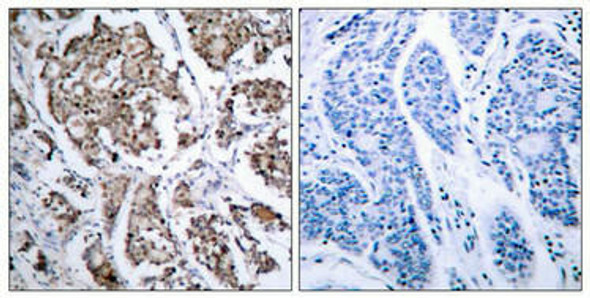Description
Phospho-Bad (Ser136) Antibody (PACO24248)
The Phospho-BAD (Ser136) Antibody (PAC0248) is a valuable tool for researchers studying the regulation of cell survival and apoptosis. This antibody, raised in rabbits, is highly specific for the phosphorylated form of the BAD protein at Ser136. Validated for use in Western blot applications, it allows for the detection and analysis of phosphorylated BAD in various cell types.BAD is a pro-apoptotic protein that plays a key role in the regulation of programmed cell death. Phosphorylation of BAD at Ser136 is known to inhibit its pro-apoptotic activity, making it an important target for understanding the mechanisms of cell survival and apoptosis.
By studying the phosphorylation status of BAD, researchers can gain insights into the signaling pathways that control cell fate decisions and potentially identify new therapeutic targets for diseases like cancer.Overall, the Phospho-BAD (Ser136) Antibody is a valuable tool for researchers interested in unraveling the complex mechanisms that govern cell survival and apoptosis. Its high specificity and sensitivity make it an ideal choice for studies in cell biology, cancer research, and drug discovery.
| Antibody Name: | Phospho-Bad (Ser136) Antibody (PACO24248) |
| Antibody SKU: | PACO24248 |
| Size: | 100ul |
| Host Species: | Rabbit |
| Tested Applications: | ELISA, WB, IHC |
| Recommended Dilutions: | ELISA:1:2000-1:10000, WB:1:500-1:1000, IHC:1:50-1:100 |
| Species Reactivity: | Human, Mouse, Rat |
| Immunogen: | Peptide sequence around phosphorylation site of serine136 (S-R-S(p)-A-P) derived from Mouse BAD. |
| Form: | Liquid |
| Storage Buffer: | Supplied at 1.0mg/mL in phosphate buffered saline (without Mg2+ and Ca2+), pH 7.4, 150mM NaCl, 0.02% sodium azide and 50% glycerol. |
| Purification Method: | Antibodies were produced by immunizing rabbits with synthetic phosphopeptide and KLH conjugates. Antibodies were purified by affinity-chromatography using epitope-specific phosphopeptide. Non-phospho specific antibodies were removed by chromatogramphy using non-phosphopeptide. |
| Clonality: | Polyclonal |
| Isotype: | IgG |
| Conjugate: | Non-conjugated |
 | Western blot analysis of extracts from HT29 cells untreated or treated with UV using BAD(Phospho-Ser136) Antibody. |
 | Immunohistochemical analysis of paraffin-embedded human breast carcinoma tissue using BAD(Phospho-Ser136) Antibody(left) or the same antibody preincubated with blocking peptide(right). |
| Background: | The protein encoded by BAD gene is a member of the BCL-2 family. BCL-2 family members are known to be regulators of programmed cell death. This protein positively regulates cell apoptosis by forming heterodimers with BCL-xL and BCL-2, and reversing their death repressor activity. Proapoptotic activity of this protein is regulated through its phosphorylation. Protein kinases AKT and MAP kinase, as well as protein phosphatase calcineurin were found to be involved in the regulation of this protein. Alternative splicing of this gene results in two transcript variants which encode the same isoform. |
| Synonyms: | Bbc2 |
| UniProt Protein Function: | BAD: a proapoptotic member of the Bcl-2 family. Displaces Bax from binding to Bcl-2 and Bcl-xL, resulting in cell death. Survival factors such as IL-3 can inhibit the apoptotic activity of Bad inducing the phosphorylation of Bad by Akt and p90RSK. 14-3-3 proteins bind phosphorylated Bad, inhibiting its binding to Bcl-2 and Bcl-xL. Phosphorylation by mitochondria-anchored PKA in the BH3 domain can block the dimerization of Bad and Bcl-xL. |
| UniProt Protein Details: | Protein type:Apoptosis Cellular Component: mitochondrial outer membrane; mitochondrion; membrane; cytoplasm; intracellular; cytosol Molecular Function:protein kinase B binding; protein binding; protein heterodimerization activity; phospholipid binding; caspase activator activity; protein kinase binding; lipid binding; protein phosphatase binding; protein phosphatase 2B binding Biological Process: positive regulation of proteolysis; apoptosis; positive regulation of apoptosis; positive regulation of caspase activity; regulation of caspase activity; cellular process regulating host cell cycle in response to virus; glucose homeostasis; positive regulation of apoptosis by virus; regulation of apoptosis; pore complex biogenesis; positive regulation of glucokinase activity; caspase activation; release of cytochrome c from mitochondria; cytokine and chemokine mediated signaling pathway; suppression by virus of host apoptosis; ADP metabolic process; positive regulation of insulin secretion; ATP metabolic process; glucose catabolic process; cell proliferation; positive regulation of T cell differentiation; induction of apoptosis via death domain receptors; DNA damage response, signal transduction resulting in induction of apoptosis; positive regulation of B cell differentiation; regulation of mitochondrial membrane permeability; positive regulation of epithelial cell proliferation |
| UniProt Code: | Q61337 |
| NCBI GenInfo Identifier: | 2493288 |
| NCBI Gene ID: | 12015 |
| NCBI Accession: | Q61337.1 |
| UniProt Related Accession: | Q61337 |
| Molecular Weight: | |
| NCBI Full Name: | Bcl2-associated agonist of cell death |
| NCBI Synonym Full Names: | BCL2-associated agonist of cell death |
| NCBI Official Symbol: | Bad |
| NCBI Official Synonym Symbols: | Bbc2; AI325008 |
| NCBI Protein Information: | bcl2-associated agonist of cell death; bcl-2-binding component 6; bcl2 antagonist of cell death; bcl-xL/Bcl-2-associated death promoter |
| UniProt Protein Name: | Bcl2-associated agonist of cell death |
| UniProt Synonym Protein Names: | Bcl-2-binding component 6; Bcl-xL/Bcl-2-associated death promoter; Bcl2 antagonist of cell death |
| Protein Family: | Bcl2-associated agonist of cell death |
| UniProt Gene Name: | Bad |
| UniProt Entry Name: | BAD_MOUSE |
















